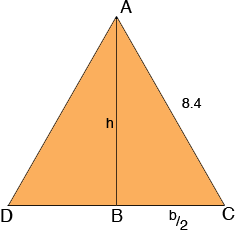| |||
| Math Central | Quandaries & Queries |
|
Question from Lisa, a student: Hi! |
Hi Lisa,
In my triangle ADC the lengths of AD and CA are each equal to 8.4 cm. The area of the triangle ADC is
25.6 = 1/2 b h
where b is the length of the base DC and h is the height, AC.

Triangle ABC is a right triangle and hence by Pythagoras' Theorem
h2 + (b/2)2 = 8.42 or b/2 = √[8.42 - h2]
Substitute this value for b/2 into the expression for the area to get
25.6 = h √[8.42 - h2]
At this point I would square each side to eliminate the square root. This gives a quartic in h but if you substitute x = h2 then you have a quadratic in x which you can solve. Finally h is the square root of x but remember that h must be positive.
Penny
 |
||
Math Central is supported by the University of Regina and The Pacific Institute for the Mathematical Sciences.